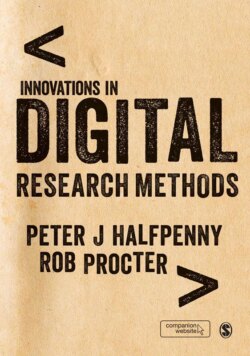Читать книгу Innovations in Digital Research Methods - Группа авторов - Страница 13
На сайте Литреса книга снята с продажи.
1.2 Background 1.2.1 e-Science
ОглавлениеOver the period 2001 to 2006, the UK Government invested £213m in an e-Science programme (Hey and Trefethen, 2004). The overall aim of the programme was to invent and apply computer-enabled methods to ‘facilitate distributed global collaborations over the Internet, and the sharing of very large data collections, terascale computing resources and high performance visualizations’.1 The funding was divided between a ‘core programme’, focused on developing the generic technologies needed to integrate different resources seamlessly across computer networks, and individual Research Council programmes specific to the disciplines they support. The Economic and Social Research Council (ESRC) allocation was £13.6m over the five years, with the major part of this investment devoted to setting up the National Centre for e-Social Science (NCeSS). The Centre had a distributed structure, with a coordinating Hub responsible for designing and managing the programme and eleven large three-year projects devoted to developing innovative tools and services and applying them in substantive fields of inquiry.
The ambition of the overall e-Science programme was to promote the adoption of innovations in digital infrastructure to facilitate bigger and faster science, with collaborators worldwide addressing major research questions in new ways. The initial technical focus was grid computing, driven by a set of ‘middleware’ standards. These are the shared protocols required for the development of sophisticated software to enable large numbers of distributed and heterogeneous computer systems to be linked and inter-operate, thereby providing researchers with seamless, on-demand access to scalable processing power to handle very large-scale datasets, regardless of the location of the researchers or the data. This model of e-Infrastructure was particularly appropriate to particle physics and such challenges as weather prediction and earthquake modelling. Advances in these areas are dependent on collecting and marshalling data on a vast scale and having huge computing resources to analyse it, accessible by large networks of research teams distributed across the world.
However, the grid computing blueprint for e-Infrastructure proved slow to mature, sometimes difficult to deploy in practice and it did not always offer the most appropriate solutions to scientists’ requirements. Meanwhile, other technologies emerged and alternative solutions to the demand for scalable computing and data storage, such as cloud computing, became available. Alongside this was the flowering of the lightweight systems that are loosely collected together under the title of Web 2.0 (O’Reilly, 2005). While these are technically less powerful than grid-based systems, their relative simplicity – both in terms of implementation effort and ease of use – made them attractive to researchers who did not need sophisticated tools and services, and who were deterred from using grid services by their complexity and the perceived barriers to access. Moreover, many of these Web 2.0 tools and services are freely available on the Internet, and users can find help in adopting them in numerous online forums and support groups. They have been widely taken up because of their ability to deliver easy-to-use services via simple protocols and familiar Web-based user interfaces, and they provide flexible solutions to at least some researchers’ needs for advanced computing tools and services. Accordingly, across the sciences the notion of grid computing being at the core of e-science gradually gave way to a wider understanding of e-Infrastructure, embracing a broad range of computing software and services that support the everyday work of scientists.
